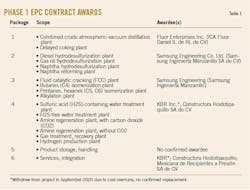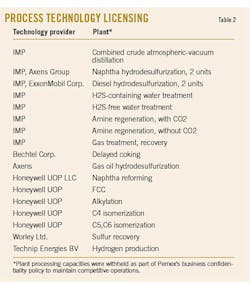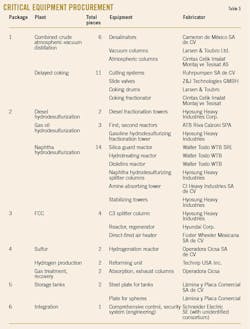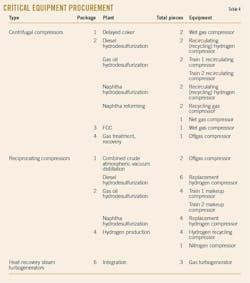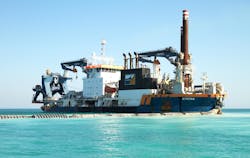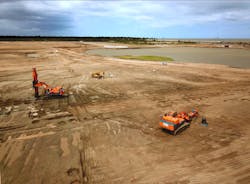The government of Mexico and Pemex Transformación Industrial (PTI), the processing arm of Mexico’s state-owned Petróleos Mexicanos (Pemex), are rapidly progressing with construction of the 340,000-b/d Dos Bocas refinery at Paraíso, in the country’s southeastern state of Tabasco.
This article provides an overview of the grassroots refinery—the country’s first in 40 years—including details regarding the complex’s proposed processing scheme, contracts awarded for engineering, procurement, and construction (EPC) activities and technology licensing of individual plants, as well as the project’s development status as of mid-January 2021.
Focus on refining
First announced in 2018, the Dos Bocas refinery forms the cornerstone of Mexican President Andrés Manuel López Obrador’s National Refining Plan (NRP) to rescue Mexico’s national oil industry and enable the country to achieve complete energy independence and security following his predecessor’s liberalization of energy policy, which focused more on attracting foreign investment to Mexican oil and gas exploration (OGJ Online, July 9, 2018).
Alongside construction of the new refinery in Paraíso, Obrador’s NRP involves ongoing rehabilitation and modernization works to boost processing capabilities at the nation’s six existing but aging refineries, including Pemex’s PTI-owned and operated:
- 190,000-b/d Francisco I. Madero refinery at Ciudad Madero, Tamaulipas.
- 285,000-b/d Gral. Lázaro Cárdenas del Río refinery at Minatitlán, Veracruz.
- 245,000-b/d Ing. Antonio M. Amor refinery at Salamanca, Guanajuato.
- 330,000-b/d Ing. Antonio Dovalí Jaime refinery at Salina Cruz, Oaxaca.
- 315,000-b/d Miguel Hidalgo refinery at Tula, Hidalgo.
- 275,000-b/d Ing. Héctor R. Lara Sosa refinery at Cadereyta, Nuevo León (OGJ Online, Dec. 11, 2020).
As a result of the NRP’s rehabilitation program—which intensified during fourth-quarter 2019 with projects aimed at enhancing processing unit mechanical integrity, safety, and efficiency, including technology upgrades to maximize processing of crude feedstock and residuals—PTI’s existing refining system increased its overall operating rate to 60% by yearend 2020 from 30% in January 2020, according to Pemex’s 2019 annual report to investors and a Dec. 23, 2020 release from Obrador.
Dos Bocas overview
The greenfield refinery along the Gulf of Mexico (GoM) will consist of 17 major plants designed to process 340,000 b/d of heavy (21-22° API), sour (3.4 wt % sulfur) Maya crude oil produced offshore southeast Mexico from Cantarell and Ku-Maloob-Zaap fields in the Bay of Campeche (Fig. 1).
Selected for its strategic location at the port—which receives about 1.1 million b/d of offshore production mostly for export—the refining complex will produce gasoline and diesel for seaborne delivery to GoM ports at Tuxpan, Pajaritos, Veracruz, and Progreso, as well as connect to Mexico’s national network of pipelines for distribution to the country’s interior and the Port of Salina Cruz for maritime delivery to the nation’s Pacific Coast ports of Acapulco, Manzanillo, Lázaro Cárdenas, Topolobampo, and Rosarito, according to Instituto Mexicano del Petróleo (IMP).
Designed with the primary objective to maximize processing of Maya crude into high-demand transportation fuels—primarily gasoline and diesel—and reduce production of less desirable products like fuel oil and asphalt, the refinery’s proposed configuration is based on extracting maximum value from bottom-of-the-barrel (BOTB) byproducts while simultaneously increasing output of higher-value products, including LPG, propylene for use by petrochemical producers, butylenes, and demand-based production of jet fuel and fuel oil. IMP’s conceptual engineering design for the refinery includes a combination of standard processing units such as a combined atmospheric-vacuum distillation plant to obtain light and intermediate products (e.g., gasoline, jet fuel, kerosine, diesel) and more complex units like a delayed coking plant, where heavier BOTB vacuum residues will be sent for further processing to increase yields of lighter products (e.g., naphtha, diesel fractions for hydrotreating). Produced coke will be used as fuel in Mexico’s cement plants, feedstock for gasification plants, and in other processes.
Mexico’s Secretaría de Energía (Sener, or ministry of energy), Pemex, and IMP said in respective July 2019 and March 2020 presentations that, once in operation, the Dos Bocas refinery will be able to produce the following:
- Gasoline, 178,000 b/d.
- Ultralow-sulfur diesel, 125,000 b/d.
- Propylene, 9,400 b/d.
- LPG, 9,300 b/d.
- Coke, 8,400 tonnes/day.
- Sulfur, 1,128 tonnes/day.
Alongside helping to fulfill Mexico’s domestic demand for cleaner-burning fuels and provide feedstock for its petrochemical complexes, the Dos Bocas refinery—budgeted for $8 billion and slated for mechanical completion in June 2022—will enable the country to halt exports in the medium term of its own crude production, the majority of which is currently marketed abroad to countries such as the US with more sophisticated refining capabilities, Obrador said in a June 2, 2020, presentation on the project.
Startup of the new refinery and completion of the NRP’s rehabilitation program for existing refineries will, by 2023, equip Mexico with a combined crude oil processing capacity of 1.54 million b/d, according to Obrador and Secretary of Energy Rocío Nahle García.
Authorized for development by Consejo de Administración de Petróleos Mexicanos (CAPEMEX) on Dec. 7, 2018, and granted conditional and final authorization to proceed with development by federal environmental regulator Agencia de Seguridad, Energía y Ambiente (ASEA) in August 2019 and January 2020, respectively, Sener and Pemex subsidiary PTI Infraestructura de Desarrollo SA de CV (PTI-ID) officially broke ground on site-preparation activities for the new refinery on June 2, 2019.
EPC, technology awards
Following the voiding of an invitation-only tender to four international firms to submit bids to act as project management contractor (PMC) for the proposed development—all of which came in above the government’s proposed budget—President Obrador announced on May 9, 2019 that Nahle García, head of Sener, and Pemex (via PTI-ID) would jointly take over PMC duties and assume supervision for the refinery’s construction.
Based on an accelerated and transparent project-execution process aligned with Obrador’s commitment to combat Mexico’s past history of corruption within its state-owned enterprises, Sener and PTI-ID, in association with IMP—which has participated since the beginning in the planning, conception, oversight, and implementation of the project’s execution—created and continue to maintain an online platform devoted solely to the refinery’s construction, technology and equipment selection, and status updates.
As part of the tendering process, Sener and PTI-ID created four packages covering EPC activities for the refinery’s 17 major processing plants, as well as two additional EPC packages, one of which is dedicated to storage and handling, and the other, to services and integration at the site. Each package is divided into two phases. Phase 1 entails delivery of front-end engineering and design (FEED), detailed engineering development of a project execution and feasibility plan, a cost estimate, preliminary works for execution of the package’s second-phase scope. Phase 2 is simply the continuation and conversion of Phase 1 works into a full-EPC contract award.
Table 1 shows the scope of work included under each of the six main EPC packages and corresponding award winners for Phase 1 works.
Table 2 shows contracts let to various service providers for delivery of technology licensing at the refinery’s main processing plants.
In addition to major EPC and technology licensing agreements, Sener and PTI-ID through its contractors have secured multiple orders for critical, long-lead equipment items (Tables 3-4). In keeping with the government’s pledge to increase inclusivity of manufacturers based in Mexico, additional contracts also are in place for all of the project’s storage tank and sphere equipment with the following domestic companies:
- Metálica Fabricaciones y Edificaciones SA de CV.
- TCC Obras e Infraestructura SA de CV.
- Impulsora de Desarrollo Integral SA de CV.
- CI Heavy Industries SA de CV.
- Construcciones Industriales y Ecológicas del Sureste SA de CV.
- LM Vaga Construcciones SA de CV.
- Fabricación y Reparación Electromecánica SA de CV.
As of late-December 2020, Sener and PTI-ID had awarded 107 contracts totaling about 40.77 billion pesos for construction of the project, according to a Dec. 21 press briefing from the government. With PMC rigorously regulated by Sener and PTI-ID, detailed public announcements by EPC contractors and technology licensors regarding their specific scope of work at the refinery have remained limited, but a few have emerged.
Contract details
At yearend 2020, Van Oord NV announced via its website that subsidiaries Van Oord de México SA de CV and Wicks BV along with consortium partner Grupo Huerta Madre SAPI de CV had completed land reclamation and dynamic compaction activities as part of a €235-million contract awarded in May 2019 to prepare the Dos Bocas site for construction. By spring 2020, less than a year after receiving the award and despite the coronavirus (COVID-19) pandemic, Van Oord hadcompleted reclaiming 12 million cu m of sand from the GoM using its Athena cutter suction-dredger to create 600 hectares of new land on which the refinery will be built (Fig. 3).
In addition to dredging and reclamation activities, Wicks used its 9-tonne rapid-impact compaction hammers and a crane dropping a 24-tonne weight to prepare about 400 hectares of the reclaimed land for rapid construction and reduce instances of settling and liquefaction beneath the refinery’s structures in the event of future earthquakes (Fig. 4).
On Oct. 30, 2020, Samsung Engineering confirmed PTI-ID let a $3.6-billion contract to subsidiary Samsung Ingenieria Manzanillo and consortium partner Asociados Constructores DBNR SA de CV for Phase 2 of its previous Phase 1 awards for FEED, detailed engineering development, and early works on Packages 2 ($84.96 million) and 3 ($57.8 million) of the Dos Bocas refinery. As part of the Phase 2 contract for Packages 2 and 3, the consortium will execute full EPC services for the complex’s diesel hydrodesulfurization, gas oil hydrodesulfurization, naphtha hydrodesulfurization, naphtha reforming, and FCC plants.
Samsung Engineering said the Phase 2 full-EPC contract award follows successful execution of Phase 1 activities, on which the consortium continues to carry out detailed engineering, ordering of major equipment, and on-site foundation works to ensure smooth construction during Phase 2 works.
Howden Group Ltd. said on Oct. 16, 2020, that its Mexico-based division received an $8.5-million order from PTI-ID to supply centrifugal fans and turboblower packages, as well as a $16-million order for six reciprocating compressors, all for deliver to the Dos Bocas refinery.
As part of the orders, Howden will supply the refinery’s sulfur recovery plant with the following:
- Three main air-blower packages.
- Four incinerator air blowers.
- Six reciprocating compressors.
For the refinery’s diesel hydrodesulfurization plant, Howden will supply six reciprocating compressors.
Project status
In a video recorded Jan. 15, 2021, and presented during President Obrador’s Jan.18, 2021, daily press conference, Sener’s Nahle García said that, following completion of Phase 1 construction activities at yearend 2020, contractors at the site have accelerated laying of foundations for the refinery’s various processing plants and are continuing with reinforcement of steel, framework, and pouring of concrete in pipe racks and electrical substations. Fabrication of coke drums and construction of plant cooling towers is also ongoing.
Fig. 5 shows recent advanced construction works at the Dos Bocas site.
In addition to progressing with development activities at the complex’s administrative buildings and control room, construction was recently completed on deep foundations for 44 vertical tanks and 31 storage spheres in the project’s product storage area, with mechanical works now underway readying the domes for assembly.
As part of the site’s integration, work also continues on a 62-km gas pipeline and 32-km aqueduct, as well as on the platform in the receiving area that will be used for heavy equipment to be framed at the port before delivery to the refining area.
Nahle García confirmed via a Jan. 8 recording presented on Jan. 11, 2020, that ICA Fluor had started work on Phase 2 of the process plants included as part of Packages 1 and 4, the latter of which ICA Flour with Technit E&C SA took over following KBR’s withdrawal from the development earlier in the year because of cost overruns, according to a Sept. 28, 2020, presentation to Mexico’s Senado de la República requesting additional oversight of the Dos Bocas project.
Nahle García said Techint also was beginning certain Phase 2 preparatory works for Package 4 during her Jan. 8 recorded message. Official details regarding KBR’s departure from and Technit’s entrance into the project have yet to be disclosed officially by either the companies or government officials.
Phase 1 development of the Dos Bocas refinery is now officially complete, however, bringing overall progress to more than 25% and keeping the refinery on track for its targeted 2022 commissioning (OGJ Online, Oct. 19, 2020).
About the Author
Robert Brelsford
Downstream Editor
Robert Brelsford joined Oil & Gas Journal in October 2013 as downstream technology editor after 8 years as a crude oil price and news reporter on spot crude transactions at the US Gulf Coast, West Coast, Canadian, and Latin American markets. He holds a BA (2000) in English from Rice University and an MS (2003) in education and social policy from Northwestern University.


